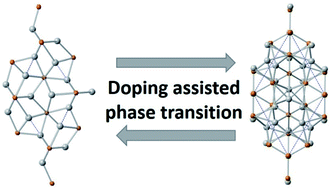Phase transformations in the nickel phosphide system induced by transition-metal doping and their electro-catalytic study†
Abstract
Nickel phosphide exists in various compositions, and the synthesis of pure-phase nickel phosphides is of immense interest due to their wide scale applications in different electrocatalytic reactions. We report the facile synthesis of nickel phosphides and rare transition metal-induced phase transformations within this system. Phase selective synthesis of pure Ni2P or Ni5P4 was achieved by decomposition of nickel acetate tetrahydrate Ni(AC)2·4H2O in optimized mixed solvent systems, i.e., in tri-octylphosphine oxide (TOPO)/tri-n-octylphosphine (TOP) or hexadecylamine (HDA)/TOP, respectively, by hot injection route. The doping of 5% Cu or Mn in either of the nickel phosphide phases yielded a mixture of phases (Ni2P/Ni5P4). However, increasing the Cu or Mn content to 10% resulted in the complete transformation of phase, i.e., from Ni2P to pure Ni5P4 and vice versa. Lattice stress and size of incorporated dopants, as well as the nature of surfactants employed, were discussed as probable causes of these rare phase transformations. Moreover, in order to establish structure–activity relationship, we studied the comparative effect of transition metal dopants in both nickel rich and nickel deficient phases. Therefore, initially formed and transformed phosphides were investigated as electrocatalysts for overall water splitting and supercapacitance. NiP-5 (Ni2P formed on 10% Cu doping of Ni5P4) delivered a current density of 10 mA cm−2 with the lowest overpotential of 146 mV among all samples for HER while NiP-3 (Ni5P4 formed from Ni2P on 10% Cu doping) similarly required the least overpotential of 276 mV for the OER at the same current density. NiP-2 (pristine Ni5P4) had the highest calculated specific capacitance of 1325 F g−1 at 2 A g−1. These phase transformations resulted in better catalytic activity and stability as well as reaction kinetics indicating suitability in practical water splitting technologies.



 Please wait while we load your content...
Please wait while we load your content...